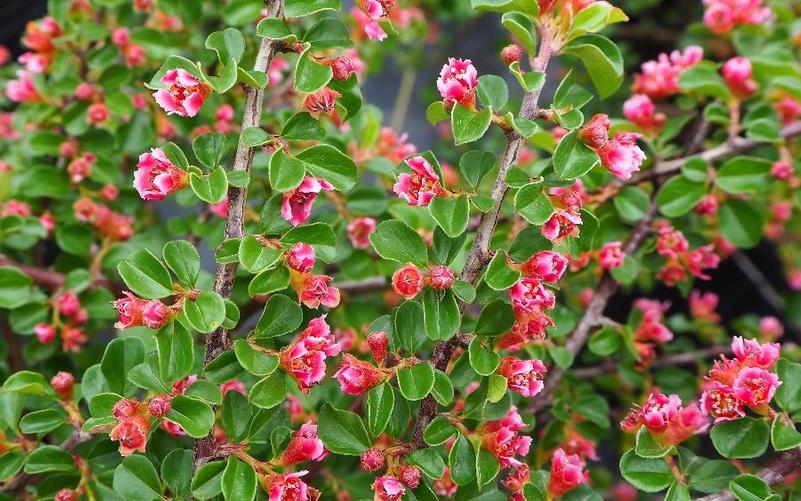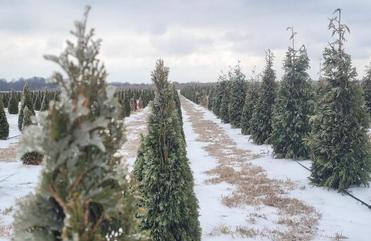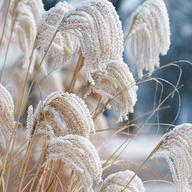Drought Tolerant Shrubs for Central and Eastern U.S.
In just about any environment, shrubs are indispensable for an attractive and comfortable home landscape. A landscape without shrubs is a little like a home without walls.

Drought Tolerant Shrubs for Central and Eastern U.S. include Cotoneaster apiculatus (Cranberry Cotoneaster) shown here.
Shrubs can give structure by creating zones and rooms, marking boundaries, and providing privacy. They can block unattractive views, blazing sun, and drying winds. Many can fill in and establish quickly. If a shrub dies, however, it may create a substantial void in the landscape. Choosing appropriate plant material for your area includes awareness of the drought tolerance of your shrubs - their ability to withstand extended periods of dry weather without dying.
Recognizing Drought - Tolerant Plants
A plant’s ability to conserve water can often be noted in its characteristics. Small leaves or needles limit water loss. Some drought-tolerant plants with large leaves have deep indentations in the leaves, reducing leaf area. Leaves covered by a waxy substance or fine hairs also cut down on transpiration. Some plants have thick fleshy roots, stems or leaves that can store water or roots that grow deeply to search out water. Other plants have special physiological adaptations that are less noticeable, such as being able to adjust the osmotic potential of their cells or regulate closure of stomatal pores in their leaves to reduce transpiration.
Use Shrubs Suited to Your Region
If you live in an area with fairly generous rainfall, your choice of a drought-tolerant plant will be different from someone who lives in a dry climate. Some plants are naturally suited to consistently dry conditions and would be obvious choices for developing a drought-tolerant landscape where precipitation is normally low. But these same plants may not fare well in a garden that has ample rainfall interspersed with periods of drought. Gardeners in the Central and Eastern United States should look for plants that can survive alternating dry and wet periods. There is limited research relating individual species to exact drought conditions but a considerable number of shrubs have been determined to withstand long periods of dry weather. The following list includes species that have consistently been recognized as shrubs that can tolerate an extended period of drought and are generally suitable for a climate with moderate temperatures and average precipitation. Choose plants that match your area’s particular soil parameters, temperature extremes, and, within the garden, particular sun exposure. Also, pay attention to how precipitation is usually distributed across the seasons in your area.
Evergreen Drought-Tolerant Shrubs
- Japanese Plum Yew (Cephalotaxus spp. and cvs.), Example Cephalotaxus harringtonia 'Fastigiata'
- Distylium (Distylium spp. and cvs.), Example Distylium ‘Vintage Jade’
- Juniper (Juniperus spp. and cvs.), Example Blue Star Juniper (Juniperus squamata ‘Blue Star’)
- Bayberry (semi-evergreen) (Myrica pensylvanica)
- Cherry Laurel (Prunus laurocerasus and cvs.), Example Prunus laurocerasus 'Chestnut Hill'
- Yew (Taxus many spp. and cvs.), Example Hicks Yew (Taxus x media ‘Hicksii’)
- Boxwood (Buxus most spp. and cvs.) Example Japanese Boxwood (Buxus microphylla japonica 'Baby Gem')
- Holly (Ilex some spp. and cvs.), Example Japanese Holly (Ilex crenata ‘Sky Pencil’)
- Firethorns (Pyracantha most spp. and cvs.) Example Narrowleaf Firethorn (Pyracantha angustifolia ‘Gnome’)
Deciduous Drought-Tolerant Shrubs
- Cotoneaster (Cotoneaster several spp. and cvs.), Example Cranberry Cotoneaster (Cotoneaster apiculatus)
- Butterfly Bush (Buddleia most spp. and cvs.), Example Buddleia ‘Lavendar Cascade'
- Bluebeard (Caryopteris spp. and cvs.), Example Caryopteris x clandonensis ‘Beyond Midnight’
- Forsythia (Forsythia most spp. and cvs.), Example Forsythia x intermedia ‘Lynwood Gold’
- Privet (Ligustrum many spp. and cvs.), Example Ligustrum vulgare 'Straight Talk'
- Blackhaw (Viburnum prunifolium)
- Japanese Spirea (Spiraea japonica many cvs.), Example Spiraea japonica 'Gold Mound'
- Glossy Abelia (Abelia x grandiflora) Example Abelia x grandiflora ‘Kaleidoscope’
- Roses (Rosa some spp. and cvs.), Example Rosa x Apricot Drift
- Japanese Barberry (Berberis thunbergii and cvs.) Example Berberis thunbergii ‘Crimson Pygmy’
- Bush Honeysuckle (Diervilla spp. and cvs.) Example Diervilla x Kodiak® Red
- Rose of Sharon (Hibiscus syriacus and cvs.) Example Hibiscus syriacus ‘Lavender Chiffon’
- Crape Myrtle (Lagerstroemia many cvs.) Example Lagerstroemia indica x fauriei 'Tonto'
- Mock Orange (Philadelphus several spp. and cvs.) Example Philadelphus coronarius Illuminati Tower™
- Common Ninebark (Physocarpus opulifolius cvs.) Example Physocarpus opulifolius Coppertina®
- Sumac (Rhus most spp. and cvs.) Example Rhus aromatica 'Gro-Low'
- Virginia Sweetspire (Itea virginica and cvs.), Example Itea virginica 'Henry's Garnet'
Measures to Aid Drought Tolerance
Within any landscape, certain factors can influence the drought tolerance of a plant. These measures can increase a plant’s chance for survival:
- In the landscape, mature plants are usually able to withstand drought better than young plants. When you purchase shrubs at a nursery, the rules change a little. Healthy developed roots are crucial to facilitate quick growth and less dependence on water. Since plant growth is stalled until the spread of the root ball catches up to the top growth, it is better to buy shrubs with the largest proportion of root ball to top growth. Large balled and burlapped shrubs have had a significant proportion of their root mass removed, and the natural outward movement of roots is restricted in container-grown plants. This means large shrubs will probably struggle more for a longer period than smaller ones which have a better proportion of root mass.
- Smaller is usually better when planting shrubs into a hedgerow too. Competition with other roots will slow root growth. So small shrubs, seedlings and whips (unbranched plants) spaced properly for a hedge will have more room to grow and will grow more quickly than larger shrubs in the same space, often overtaking them in a short time.
- Even plants considered drought-tolerant need a period of adjustment after planting until root growth is able to support the plant. It may be necessary to give shrubs supplemental watering up to several years after planting, depending on the condition of the shrub at planting. Eventually allow your shrub to dry out slightly between waterings to further encourage the roots to seek out water and become more self-sufficient.
- Planting where shrubs are protected from wind and afternoon sun can conserve soil moisture.
- The type of soil can affect moisture retention. Sandy soil drains the quickest while clay soil is on the other end of the spectrum, holding water more than other soil types. However, unless it is a wetland plant, the majority of plants benefit from well-draining soil. Mixing compost into the soil can help retain moisture in sandy soil and increase drainage in clay soil.
- Planting in the fall takes advantage of increased root growth during this time. Also, think about planting when you expect to have rain.
- Working mycorrhizal root inoculants into the soil will increase the ability of the roots to take up water.
- Mulching conserves soil moisture.
- Weeding regularly will remove weeds that compete for moisture in the soil.
- Using organic slow-release fertilizers will limit sudden, increased plant growth which would require more water to sustain the plant.
Low-Water Use Gardening is Always a Win
Although most of the Central and Eastern parts of the country aren’t typically dry enough to be called desert or xeric, it’s still a plus to apply practices of low-water-use gardening such as the use of drought-tolerant plants.

